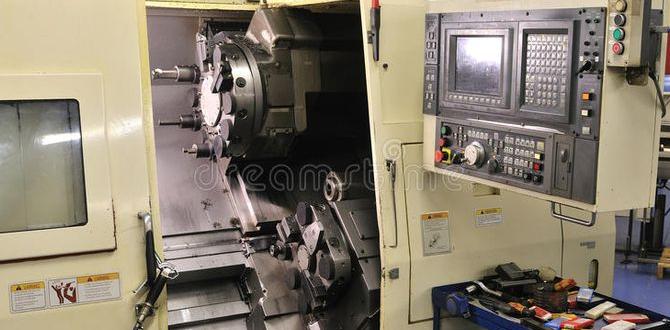A 1/8″ carbide end mill with a 1/4″ shank and stub length is a reliable choice for milling mild steel. It offers good rigidity and chip clearance, leading to longer tool life and cleaner cuts for beginner machinists.
Are you ready to tackle mild steel with your milling machine but feeling a bit unsure about which end mill to pick? It’s a common question for anyone starting out in machining. Getting the right tool makes all the difference between a clean cut and a frustrating struggle. Don’t worry, I’m Daniel Bates from Lathe Hub, and I’m here to make it simple. We’ll explore how a specific type of 1/8″ carbide end mill is a fantastic choice for mild steel, giving you confidence in your cuts. Let’s get those projects moving!
Choosing the Right Tool: Why a 1/8″ Carbide End Mill Shines for Mild Steel
When you’re just getting started with milling, selecting the correct cutting tool can feel like navigating a maze. Mild steel, a popular material for many DIY and hobby projects, presents its own set of challenges. It’s not as soft as wood, but it’s not as tough as hardened steel. This is where a well-chosen 1/8-inch carbide end mill, particularly one designed for general-purpose milling and possessing specific features, becomes your best friend.
Carbide is a material known for its hardness and ability to withstand higher temperatures than traditional high-speed steel (HSS). This means it can cut harder materials and maintain its sharpness for longer periods. For a beginner, this translates to less tool wear, fewer tool changes, and a more forgiving cutting experience. The 1/8-inch size is also incredibly versatile for creating small details, slots, and cutouts often needed in hobbyist projects. Let’s break down why this specific combination is so effective.
Understanding the Key Features
Not all carbide end mills are created equal. For milling mild steel successfully, especially as a beginner, specific features within the end mill’s design significantly contribute to its performance and your success. We’re focusing on a 1/8-inch diameter end mill, often paired with a 1/4-inch shank for rigidity, and frequently found in a ‘stub’ length configuration.
- Carbide Material: This is the cornerstone. Carbide offers superior hardness compared to HSS, meaning it stays sharp longer and can handle the heat generated when cutting steel. For beginners, this means fewer mistakes due to a dull tool and more predictable results.
- 1/8-inch Diameter: This small diameter is perfect for intricate work. It’s ideal for cutting narrow slots, chamfering small edges, or creating fine details that larger tools simply can’t achieve. It also requires less power from your milling machine, making it suitable for smaller benchtop machines.
- 1/4-inch Shank: While the cutting diameter is small, having a larger 1/4-inch shank provides more rigidity. This reduces chatter and vibration, leading to a smoother finish and preventing tool breakage. A smaller shank (like 1/8-inch on a 1/8-inch end mill) would be much more prone to breaking under stress.
- Stub Length: A “stub” length end mill is shorter than a standard length end mill. This reduced flute length (the part with the cutting edges) means increased rigidity. Less overhang means less chance of the tool flexing and breaking, which is a huge plus for beginners who might be pushing the tool a bit too hard or incorrectly. It also keeps the cutting forces closer to the spindle, further improving stability.
- Number of Flutes: For mild steel, 2-flute or 3-flute end mills are generally recommended.
- 2-flute: These offer excellent chip evacuation, which is crucial when milling softer, gummy materials like mild steel. They also have more space between the flutes for chips to escape.
- 3-flute: These can often run slightly faster and provide a smoother finish than 2-flute end mills, but they can sometimes pack chips more readily in softer materials if not managed properly. For beginners, a 2-flute often presents fewer chip evacuation headaches with mild steel.
- Coating: While not always present on every beginner-friendly end mill, coatings like TiN (Titanium Nitride) can further enhance performance by reducing friction and increasing hardness, leading to even longer tool life. However, for general-purpose mild steel work, uncoated carbide is often sufficient and more budget-friendly.
The “Why”: Benefits for Beginners and Hobbyists
Why is this specific configuration so good for those venturing into metal milling? It boils down to a few key advantages:
- Increased Rigidity & Reduced Breakage Risk: The combination of a stub length and a larger shank provides excellent stability. This is critical for beginners who are still developing a feel for cutting forces and may inadvertently overload the tool. Less flexing means a much lower risk of snapping the end mill, saving you money and frustration.
- Better Surface Finish: A more rigid tool is less prone to vibration and chatter. This means cleaner, smoother cuts on your mild steel parts, reducing the need for extensive finishing work.
- Longer Tool Life: Carbide’s inherent hardness, combined with the rigidity of the stub length, allows the end mill to maintain its sharpness through more cuts. This is a significant advantage for beginners as it makes the cutting process more predictable and less error-prone.
- Versatility for Detail Work: The 1/8-inch diameter opens up possibilities for detailed parts, intricate designs, and small features that are often required in hobbyist level projects, such as custom brackets, enclosures, or moving parts.
- Ease of Use (with proper settings): While no tool is entirely “set it and forget it,” this type of end mill is forgiving. When paired with appropriate speeds and feeds (which we’ll get to), it provides a solid baseline for successful milling operations on mild steel without requiring advanced knowledge.
Setting Up for Success: What You’ll Need
Before you even think about powering up the mill, gathering the right supporting equipment is crucial. Having the proper setup ensures you can utilize your 1/8″ carbide end mill effectively and safely. Think of it like preparing your ingredients before cooking – it makes the whole process smoother and the end result much better.
Essential Equipment and Tools
Here’s a checklist of what you’ll likely need to have on hand:
- Your Milling Machine: This could be a benchtop CNC, a manual mill, or even a milling attachment for a metal lathe if you’re getting creative. Ensure it’s in good working order and properly calibrated.
- The Right End Mill: A 1/8″ diameter, 1/4″ shank, stub length, 2-flute carbide end mill designed for general-purpose or ferrous metal milling.
- Collet Chuck or ER Collet: To securely hold the 1/4″ shank of your end mill in the milling machine’s spindle. A good quality collet chuck is essential for runout and rigidity.
- Workholding: This is how you’ll secure your workpiece (the mild steel block) to the milling machine’s table. Common options include:
- Vise: A sturdy machine vise is the most common and versatile. Make sure it has hardened and ground jaws for better grip without marring your workpiece.
- Clamps: T-slot clamps, edge clamps, or strap clamps can be used for specific setups, often in conjunction with parallels or riser blocks.
- Measuring Tools:
- Digital Caliper: For measuring material dimensions, hole sizes, and checking cut depths.
- Height Gauge or Depth Micrometer: For precisely setting tool height and measuring cut depths.
- Workpiece Material: A block or sheet of mild steel. Common grades like 1018 or A36 are excellent for beginners. Ensure it’s clean and free from rust or excessive scale.
- Coolant or Lubricant (Recommended): While dry milling is possible, using a cutting fluid or lubricant designed for steel will significantly improve tool life, surface finish, and chip evacuation. Options include spray coolants, mist systems, or even a simple cutting paste.
- Safety Gear: THIS IS NON-NEGOTIABLE.
- Safety Glasses: Always, without exception.
- Face Shield: Highly recommended when milling metal, especially for added protection.
- Gloves: Wear them when handling material, but NEVER when operating the machine.
- Hearing Protection: Can be beneficial during longer milling operations.
- Chip Brush or Vacuum: For safely removing chips from the machine and workpiece.
Preparing Your Workpiece
A little preparation goes a long way. Before you start milling, take these steps with your mild steel block:
- Clean the Material: Remove any oil, dirt, or rust from the surface. A wire brush or degreaser works well.
- Check for Squareness: If you need precise results, ensure your workpiece surfaces are square and flat. A quick check with a machinist’s square can save headaches later.
- Securely Mount the Workpiece: This is paramount! Use your vise or clamps to firmly hold the steel on the milling machine table. Ensure the jaws of the vise are applying pressure to solid parts of the workpiece and not just thin sections that could deform. Use parallels under the workpiece if needed to raise it for the vise jaws, ensuring it’s stable and won’t move during milling.
- Deburr Edges: If you’re starting with a cut piece of steel, file or de-burr any sharp edges. This makes handling safer and can prevent chips from interfering with your workholding.
Step-by-Step Milling with Your 1/8″ Carbide End Mill
Now for the exciting part! Let’s get your 1/8″ carbide end mill cutting into that mild steel. Remember, patience and precision are your best friends here. We’ll aim for conservative settings to ensure success.
1. Installing the End Mill
This is a critical step for accuracy and safety. A poorly seated end mill can lead to runout (wobble), poor surface finish, and even breakage.
- Clean the Spindle and Collet: Ensure both the inside of your milling machine’s spindle taper and the outside of the collet are clean and free of debris.
- Insert the End Mill into the Collet: Place your 1/4″ shank end mill into the appropriate 1/4″ collet. Make sure it seats fully and is not angled.
- Secure the Collet: Insert the collet containing the end mill into the milling machine spindle. Tighten the drawbar or nut that secures the collet in the spindle according to your machine’s manual. Ensure it’s snug and there’s no wobble.
2. Setting Your Zero and Depth
Accurate depth control is key. This is where your measuring tools come into play.
- Locate Your X and Y Zero: This is the starting point for your milling operation. For simple operations, it might be a corner of your workpiece. Use your machine’s DRO (Digital Readout) or handwheels to position the end mill precisely where you want to start.
- Set Your Z-Axis Zero (Surface of the Workpiece):
- Carefully bring the tip of the end mill down until it just kisses the top surface of your mild steel workpiece.
- If using a DRO, touch off the end mill to the surface and set your Z-axis to 0.000″.
- If using a paper method (less precise but functional for some machines), gently slide a piece of paper between the end mill tip and the workpiece. Lower the spindle until the end mill just catches the paper, preventing it from sliding freely.
- Calculate and Set Your Cut Depth: If you want to cut to a depth of, say, 0.050 inches, you will lower the spindle (or raise the table) by that amount from your Z-axis zero. Always double-check your depth setting before engaging the cut.
3. Determining Speeds and Feeds (Crucial for Beginners)
This is often the most intimidating part for newcomers, but we can use simple, conservative estimates for this specific end mill and material combination. High speeds and fast feeds can quickly break a small end mill, while too slow can cause rubbing and poor finish.
General Rule of Thumb for 1/8″ Carbide End Mill on Mild Steel:
- Spindle Speed (RPM): Aim for a conservative starting point. For a 1/8″ carbide end mill, speeds between 3,000 and 6,000 RPM are common, but for beginners on less rigid machines, starting lower is safer. Let’s suggest: 2,000 – 3,000 RPM.
- Feed Rate (IPM – Inches Per Minute): This is how fast you push the material into the cutter. For a 1/8″ end mill in mild steel, a conservative feed rate of 3-8 IPM is a good starting point. This might feel slow, but it’s much better than breaking your tool.
Important Considerations:
- Chip Load: The ideally desired amount of material the tool removes with each revolution. For a 1/8″ end mill, a chip load of 0.001″ to 0.003″ is often targeted. If you divide the RPM by the IPM, you can get an idea of your actual chip load. (e.g., 2000 RPM / 5 IPM = 400, which is a very low chip load, meaning you might be able to increase speed or feed).
- Machine Rigidity: Less rigid machines need slower feeds and speeds.
- Coolant/Lubrication: Using coolant allows for higher speeds and feeds.
- Hear and Feel: Listen to the sound of the cut. A smooth whirring is good; a harsh screeching or chattering indicates problems (too fast, too slow, too deep, or not rigid enough).
Online Calculators: For more precise recommendations, you can use online CNC speed and feed calculators. Search for “CNC speed and feed calculator” and input your end mill diameter, material, RPM, and desired chip load. These are great resources to learn from. For example, the Calculator.net Feed Rate Calculator can help estimate, though actual results will vary.
4. Performing the Cut
With everything set, it’s time to make the cut. Remember, engage the spindle before plunging the end mill into the material.
- Engage Spindle: Turn on your milling machine spindle to the desired RPM.
- Plunge (if necessary): If you need to cut into the material from the top (a plunge cut), do so slowly. Ensure your lubricant is active. Make plunge cuts slowly, especially with a 1/8″ end mill.
- Begin Milling: Move the workpiece into the spinning end mill (or move the spindle, depending on your machine). Use your machine’s handwheels for manual control or send your programmed path for CNC.
- Use Lubrication: Apply your chosen cutting fluid as the end mill cuts. This is vital for keeping the carbide cool and preventing chips from welding to the flutes.
- Watch and Listen: Pay close attention to the sound and vibration. If you hear any harsh screeching or feel excessive chatter, stop the machine immediately.
- Take Shallow Passes: Especially for beginners, it’s much safer to take multiple shallow passes rather than one deep pass. For a 1/8″ end mill in mild steel, a depth of cut (DOC) of 0.010″ to 0.030″ per pass is very conservative and safe. You can gradually increase this if the cut is smooth and the machine is rigid enough.
- Chip Evacuation: Ensure chips aren’t building up. If they are, you might need to slow your feed rate, increase your spindle speed slightly, or take a slightly shallower pass. For 1/8″ mills, use your brush to clear chips frequently between passes or during shallow continuous cuts.
- Finishing Pass (Optional): For critical dimensions or an extra-smooth finish, consider taking a final pass at a very shallow depth (e.g., 0.002″ – 0.005″) at a slightly slower feed rate.
5. Finishing and Inspection
Once your milling operation is complete:
- Retract the Tool: Carefully retract the end mill completely out of the workpiece.
- Turn Off Spindle: Once the tool is clear, turn off the spindle.
- Clean the Workpiece and Machine: Use your chip brush and a rag (with solvent if





